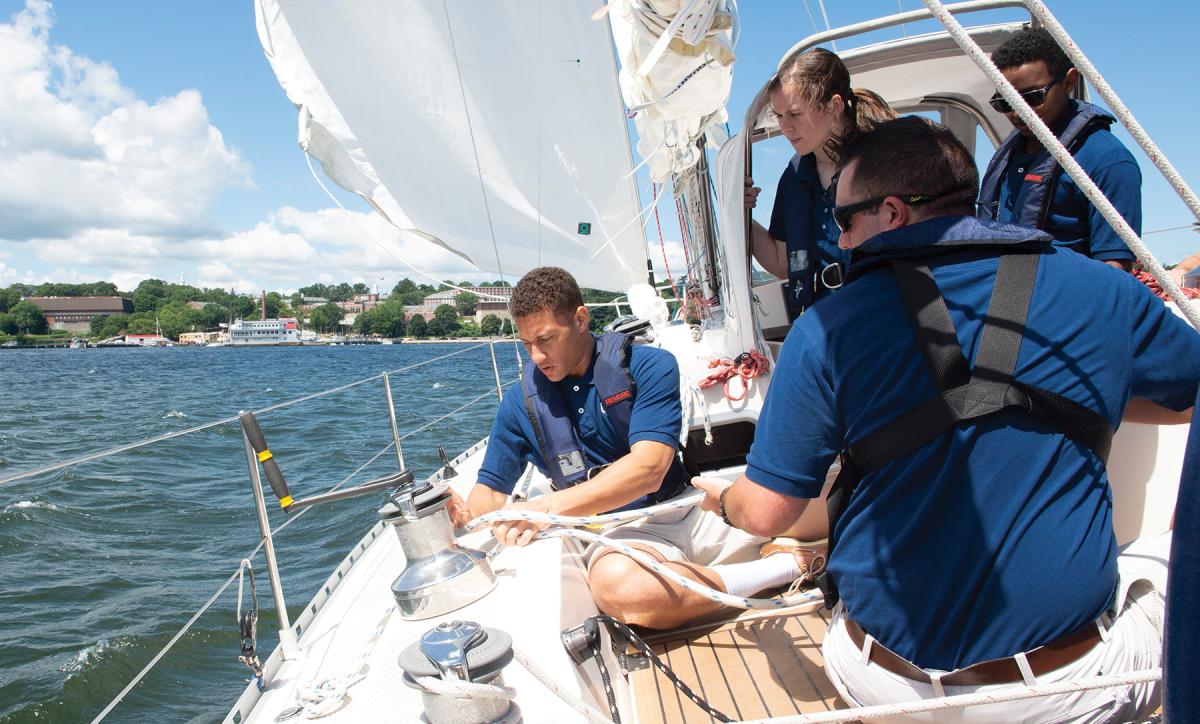Training under sail for future officers, whether on board a sailing dinghy, small keelboat, or square-rigged sailing vessel, has never been more important. In an age of electronic navigation and advanced bridge simulators, nothing can replace the experience of going to sea under sail and feeling the power of the wind and waters that shape one’s voyage and sharpen the senses. Sailing is transformative; it enhances environmental awareness and develops in a person a respect for the sea—fundamental lessons that will last a lifetime.
Learning to sail a small boat and being under sail on board larger vessels are integral training elements of modern-day maritime professional and leadership development. Fortunately, many nations understand the value of sail training, and they operate a fleet of merchant marine and navy sailing vessels—the “tall ships” as they are affectionately known worldwide. In the United States, the Naval Academy, Merchant Marine Academy, and state maritime academies all have some form of basic sail training.
Sail training has always been an essential part of the U.S. Coast Guard Academy. The Coast Guard’s predecessor, the Revenue Cutter Service, from 1877 trained its future officers on board the cutters Dobbin, Chase, and Itasca. The three-masted barquentine Alexander Hamilton later served the Academy’s sail training needs until 1930. During World War II, the Danish full-rigged sail training ship Danmark remained in U.S. waters to avoid capture by Germany and trained approximately 5,000 cadets at the Coast Guard Academy.
This positive experience led the Coast Guard to acquire as a war reparation the German sail training barque Horst Wessel, built in 1936 by Blohm & Voss in Hamburg. After commissioning in Germany as the USCGC Eagle (WIX-327) in June 1946, the ship was sailed to the United States by Captain Gordon McGowan and his mixed Coast Guard and volunteer German crew. The Eagle proudly serves the nation today as “America’s Tall Ship” and the fully operational flagship of the Coast Guard fleet, training Academy cadets and officer candidates (Coast Guard and NOAA) in basic seamanship, shipboard life, and leadership under sail.
The cadet sailing experience during four years focuses on three key components: a learning to sail program in small dinghies conducted at the Academy’s waterfront (a training activity since the early 1950s); sail training on board the Eagle on one or multiple cruises; and a Coastal Sail Training Program on board the Academy’s Leadership 44 training sloops (a more limited offshore training program has existed since the 1960s). The strategic goal is for every Academy graduate to have all three experiences, a laudatory goal achieved during the past seven years.
The first summer for new Academy cadets, called swabs, is a baptism of military training (boot camp) and time at the waterfront learning and how to sail. That first summer, swabs are on board the Eagle for an intense training cruise learning basic shipboard routine, watchstanding, seamanship, navigation, and the challenges of maneuvering a square-rigged sailing ship; climbing aloft and furling sail on a yard with a rolling ship below is a character builder they will never forget! The Eagle is a premier afloat leadership laboratory that emphasizes team building and other skills by through a host of sailing ship evolutions.
During their third summer, each cadet participates as a member of a crew of seven classmates with one safety officer on board a 44-foot coastal training sloop. The Coastal Sail Training Program represents the crucial bridge between learning to sail a small boat and sailing on board the cutter Eagle. A squadron of sloops sail in New England waters for two weeks to ports such as Newport, Martha’s Vineyard, and Block Island. Cadets are assigned permanent duties for the voyage (i.e., operations, commissary, and engineering officers) and operational watch positions that rotate. Leadership competencies are observed and evaluated, including communications, team building, technical proficiency, accountability, and taking care of one’s people. This program has been judged by the cadets to be one of the most effective and well-liked at the Academy.
Training under sail is alive and well in the 21st century and remains at the heart and soul of the Coast Guard Academy. The Coast Guard officer corps is stronger for this long-held vision.



